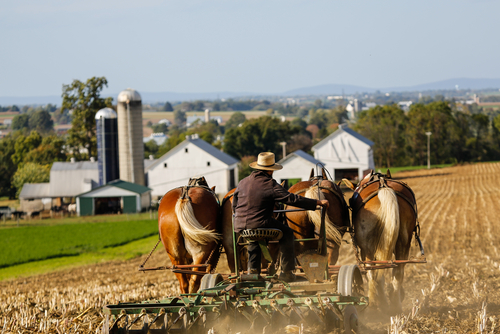You’ve probably seen the images—Amish farms with sprawling gardens, hand-built barns, and rows of crops stretching as far as the eye can see. There’s a quiet confidence in their way of life, an unshakable resilience that makes you wonder: How do they do it?
While the rest of the world scrambles for supplies at the first sign of trouble, the Amish don’t panic. They don’t rely on grocery stores, supply chains, or government assistance. They’ve spent generations perfecting a self-sufficient lifestyle that doesn’t just survive crises—it thrives in them.
So, what’s their secret? And more importantly, what can preppers and survivalists learn from them?
The Amish Don’t Prep—They Live It
Most of us treat self-sufficiency like a hobby. We stockpile canned goods, maybe plant a few tomatoes in the backyard, and call it a day. The Amish? They don’t “prep” because preparedness isn’t something they turn on and off—it’s woven into their daily existence.
Think about it:
No electricity? They’ve been living without it for centuries. Candles, oil lamps, and daylight dictate their rhythms, not power grids.
Supply chain collapse? They grow, raise, or barter for nearly everything they need. If the trucks stop running tomorrow, their pantries are already full.
Economic crash? Their communities operate on trade and mutual aid, not debt or speculation. Cash is secondary to real, tangible goods.
While modern survivalists debate the best freeze-dried meals or solar generators, the Amish are quietly doing what they’ve always done—feeding their families with food they produced themselves. They don’t just react to emergencies; they’ve structured their lives so that emergencies barely affect them.
And here’s the thing—this isn’t some extreme survivalist experiment. It’s just Tuesday for them.
Food Production: More Than Just a Garden
Sure, plenty of people grow vegetables. But the Amish take it to another level. Their farms aren’t just productive—they’re diverse, designed to provide year-round sustenance with minimal outside input.
Walk onto an Amish homestead, and you’ll see:
Heirloom crops – They save their own seeds, ensuring they’re never dependent on commercial suppliers. These varieties are often hardier, better suited to local conditions, and more resistant to pests.
Livestock on pasture – Cows, pigs, chickens, and goats aren’t just fed grain—they’re rotated through fields to fertilize the soil naturally. Nothing goes to waste.
Root cellars and smokehouses – Without refrigeration, they’ve mastered other ways to preserve food. A well-built root cellar keeps potatoes, carrots, and cabbages fresh for months. Smoking and salting meat extends its shelf life without electricity.
Communal harvests – When it’s time to bring in the crops or butcher livestock, neighbors pitch in. No one family bears the burden alone.
The Art of Preservation: How the Amish Make Food Last
The Amish don’t just grow food—they make sure it lasts. While modern preppers might rely on freezers and canned goods from the store, the Amish use time-tested methods that don’t depend on electricity.
Canning: Every Amish kitchen has rows of jars filled with fruits, vegetables, and even meats. They don’t can because it’s trendy—they do it because it works.
Water bath canning for high-acid foods like tomatoes, pickles, and jams.
Pressure canning for low-acid foods like green beans, corn, and meats.
The key? They do it in bulk. When the garden overflows with produce, they don’t let it go to waste—they preserve it.
Fermentation:
Before grocery stores sold kombucha, the Amish were fermenting their own sauerkraut, pickles, and even dairy.
Sauerkraut – Just cabbage, salt, and time. No fancy equipment needed.
Fermented pickles – Crisp, tangy, and full of gut-healthy bacteria.
Cheese and yogurt – Made from raw milk and cultured at room temperature.
Fermented foods don’t just last—they’re more nutritious and easier to digest. Not to mention that a diet rich in probiotics (that every fermented food contains) promotes a long and healthier life.
Drying and Smoking:
When it comes to making food last without modern appliances, few methods are as reliable—or as ancient—as drying and smoking. The Amish have perfected these techniques over generations, turning seasonal abundance into year-round sustenance.
Dried Fruits and Herbs:
In late summer and fall, Amish kitchens buzz with activity as they prepare fruits and herbs for drying. The process is simple but effective:
Apples are peeled, cored, and sliced into rings before being strung on twine or laid out on wooden racks. Hung in a warm, dry attic or placed in the sun, they slowly transform into sweet, chewy snacks that last all winter.
Berries like strawberries, blueberries, and raspberries are spread thinly on screens to dry. Once shriveled and leathery, they’re stored in jars for adding to oatmeal, baking, or eating as a quick energy boost.
Herbs such as thyme, sage, and mint are tied in small bundles and hung upside down in a shady, well-ventilated spot. Once brittle, the leaves are crumbled into jars, preserving their flavor and medicinal properties for teas and cooking.
The key to success? Low, consistent heat and good airflow. Unlike modern dehydrators, the Amish method requires no electricity—just patience and knowledge of how to work with natural conditions.
Jerky and Smoked Meats:
Meat preservation is where smoking truly shines. The Amish don’t just make jerky—they smoke entire hams, bacon, and sausages using techniques that date back centuries. Here’s how they do it:
Salt-Curing First – Before smoking, meats are packed in salt or brined to draw out moisture and inhibit bacterial growth. Some recipes include sugar, spices, or even a touch of nitrates for longer shelf life.
Hardwood Smoke for Flavor and Preservation – Hickory, applewood, or oak chips smolder slowly in a smokehouse, enveloping the meat in antimicrobial smoke. This step not only adds rich flavor but also creates a protective barrier against spoilage.
Air-Drying for the Final Touch – After smoking, some meats are hung in a cool, dry place to further concentrate flavors and ensure long-term storage.
The result? Protein that stays edible for months without refrigeration. A single smoked ham can feed a family through the winter, and jerky becomes the ultimate survival snack—lightweight, nutrient-dense, and ready to eat anytime.
Root Cellars: Nature’s Refrigerator
If you’ve ever dug into a crisp, sweet carrot in the dead of winter or enjoyed a firm potato long after harvest season, you’ve tasted the magic of a well-built root cellar. The Amish don’t just use these underground storage spaces—they rely on them as a cornerstone of food security.
How Root Cellars Work
A proper root cellar leverages three natural principles:
Earth’s Insulation – Buried partially or completely underground, the cellar stays between 32°F and 40°F (0°C to 4°C) year-round—cool enough to slow spoilage but above freezing.
Humidity Control – Dirt floors or water trays maintain 85-95% humidity, keeping veggies from shriveling. Vents allow airflow to prevent mold.
Darkness – Like a cave, the absence of light prevents sprouting and spoilage.
What You’ll Find in an Amish Root Cellar
Potatoes – Stored in bins or burlap sacks, kept separate from apples (which emit ethylene gas that causes spuds to sprout).
Carrots and Beets – Packed in damp sand or sawdust to maintain moisture, these roots stay crunchy for months.
Cabbage – Hung upside down or wrapped in newspaper, heads slowly ferment into a rudimentary sauerkraut over time.
Apples – Placed on slatted shelves, certain varieties like Fuji or Granny Smith can last until spring if stored properly.
Winter Squash – Butternut and acorn squash rest on shelves, their hard skins protecting the sweet flesh inside.
Beyond Vegetables
Amish families often expand their root cellars’ roles:
Dairy Products – Butter and cheese can be stored in tightly sealed containers for extended periods.
Canned Goods – While not traditional, some modern Amish use root cellars to store home-canned foods, taking advantage of the stable temps.
Wine and Ferments – Crocks of sauerkraut or homemade wine benefit from the cellar’s consistent conditions.
The beauty of a root cellar? It’s a zero-energy solution that works 24/7, whether the grid is up or down. While modern preppers invest in expensive freezers and generators, the Amish simply walk downstairs to grab dinner—no electricity required.
The Power of Community
A lot of prepping thinking revolves around the lone wolf—the rugged individualist who can outlast doomsday with nothing but grit and a well-stocked bunker. The Amish know better.
Their survival strategy isn’t built on isolation; it’s built on community. When a barn burns down, neighbors show up the next day to rebuild it. When a family falls ill, others bring food. No one hoards because they know that in a real crisis, no one makes it alone.
How Their System Works
Bees (Work Parties) – Need a barn raised? The whole community shows up. In exchange, you help when others need it.
Food Sharing – If one family has a surplus of milk, another might trade fresh-baked bread. Money rarely changes hands.
Skill Pooling – Not everyone is an expert at everything, but collectively, they have all the skills needed to thrive.
Imagine that—a world where people actually help each other instead of turning every disaster into a competition. It’s a radical idea in modern prepping circles, but the Amish have proven it works.
Skills Over Gadgets
Ask the average prepper what they’d do if the grid went down, and they’ll probably list off their gear: solar panels, water filters, maybe a fancy rocket stove. The Amish? They’d just keep doing what they’ve always done.
Because here’s the truth: Tools break. Knowledge doesn’t.
The Amish don’t need YouTube tutorials to:
Butcher a hog – They know how to use every part, from the meat to the lard to the bones for broth.
Bake bread in a wood stove – No electric mixer? No problem.
Make soap from scratch – Lye + fat = clean clothes and dishes, even without Walmart.
Meanwhile, most of us would struggle to start a fire without a lighter.
That’s not to say technology is bad—but when you depend on it, you’re one power outage away from helplessness.
What Preppers Can Learn
You don’t have to sell your car and start wearing a bonnet to adopt some Amish wisdom. Here’s how to integrate their resilience into a modern preparedness plan:
- Grow More, Buy Less
Start small with a garden, even if it’s just herbs and tomatoes. As you gain confidence, learn to save seeds so you’re not reliant on stores for next year’s planting. If you’re ready to take it further, consider raising chickens for eggs—they’re often called the gateway livestock for good reason, offering a steady food source with relatively low maintenance.
- Learn Real Skills
Mastering practical skills ensures you can rely on yourself when it matters. Begin with canning—start simple, like pickles or jam, then expand to other preserves. Baking is another essential skill; challenge yourself to make bread without a bread machine. If you hunt or raise animals, learn basic butchering so you can process meat safely and efficiently.
- Build a Community
Self-sufficiency doesn’t mean going it alone. Get to know your neighbors—relationships matter when resources are tight. Organize skill-sharing sessions; someone might know how to fix engines while another excels at gardening. Whenever possible, barter instead of always relying on cash—it strengthens connections and keeps resources circulating locally.
- Reduce Dependence on Tech
Modern conveniences can fail, so have manual backups for essentials, like a hand pump for water or cast-iron cookware for off-grid cooking. Learn to preserve food without electricity, using methods like fermentation, drying, or root cellaring. Occasionally practice doing things the “hard way”—whether it’s washing clothes by hand or cooking over a fire—so you’re never caught off guard.
- Live the Life Now
Don’t wait for disaster to test your preps. Start cooking from scratch, mending clothes, and fixing things yourself in your daily life. The more self-sufficient you are now, the easier any crisis will be—because you’ll already be living the skills that others might scramble to learn.
Concluding
The Amish don’t survive crises because they have the best gear or the biggest stockpile. They survive because their entire way of life is designed for resilience.
You don’t have to go full homesteader to benefit from that mindset. But if you want to eat when the trucks stop running, it might be time to think less about what you own and more about what you can do.
So—how much of your survival plan depends on things you didn’t make yourself? And what’s one skill you could learn this week to change that?
Read full article here


